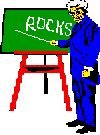
The fact that you are looking at this page suggests that you have an interest in how others are using the Internet/multimedia to enhance learning in the geosciences. Please take a few minutes to respond to a survey.
I have been collecting URLs for about 5 years and continue to struggle with how to portray this information so that it is useful to the reader and relatively easy for me to maintain.
I have decided to provide several options:
The resources have been arranged according to broad categories with each category subdivided into content-based subcategories.
The purpose of this page is to focus on those resources which illustrate good practices and might be adopted by, or prove suggestive, to others. Clearly, there is an element of personal judgment in producing such lists and the author bears full responsibility for the contents. I am always interested in being aware of new resources and will gladly accept nominations.
Each record includes the following information:
Each category is further classified into one of the following content-based Subcategories:
A judgment was made as to where the resource would fit into the following subject matter areas. Clearly, this is a personal opinion and the user is encouraged to not restrict their searches to a single subcategory.
ANON - Another Node On the interNet
[Resources for those interested in Geosciences, Mathematics and Computing]
Successes in Creating Multimedia-Assisted Learning
Environments - The Sage on the Stage Versus the Guide on the Side -- Yet Another Divide to Cross
[Papers presented at the October, 1999 Meeting of the Geological Society of America Annual Meetings, Denver, Colorado]
Creating Learning Environments with the Internet and Multimedia
[Papers presented at the October, 1998 Meeting of the Geological Society of America Annual Meetings, Toronto, Canada]
Macintosh Computer Applications in Undergraduate Geoscience Courses
[Short courses (1995 and 1996) held at San Francisco State University in conjunction with the AGU Fall Meetings]
Science and Mathematics Internet Courses and Course Resources
[Resources for Life Sciences, Chemistry, Computer Sciences, Earth Sciences, Mathematics and Physics]
It is imperative that we respect and protect the intellectual property of the individuals who designed and implemented the resources. I think it is proper to correspond with the individual if you want to use his/her resource for one of your exercises. Find out if they are prepared for what might be a fairly high demand on their server. It would be easy to strip out the text and accompanying images and put them on your server. This raises serious ethical issues. Perhaps the author would allow you to operate a "mirror" site. Most developers are proud of their efforts and it is always good form to ask.
November 16, 1999
Return to the Virtual Geosciences Professor's Home Page
Since July 13, 1999